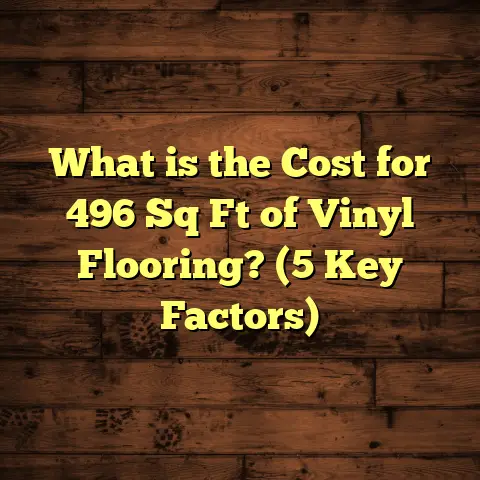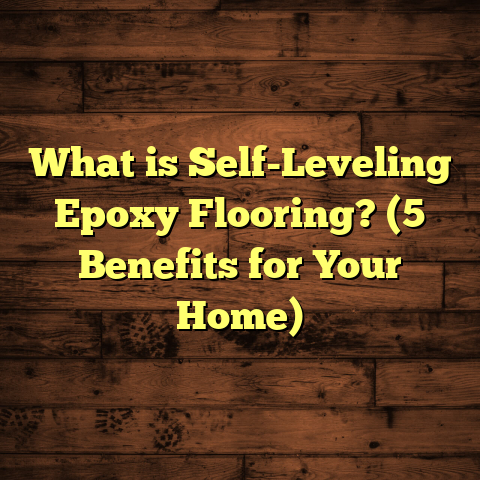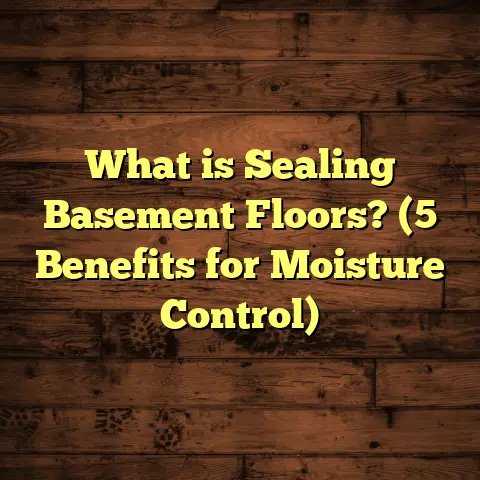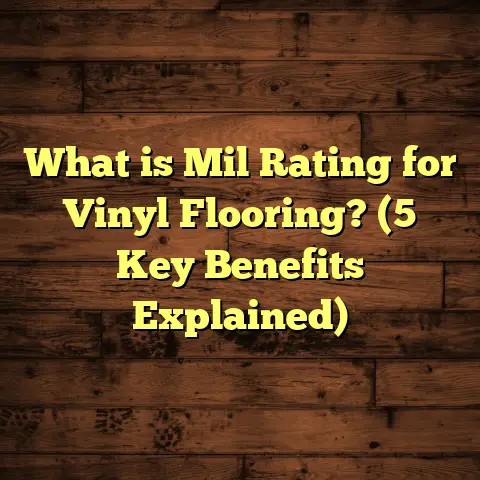What is Parquet Floor? (5 Reasons to Choose Parquet Flooring)
Comfort is something I’ve always valued in a home, and if you ask me what truly makes a space feel warm and inviting, my answer often comes down to what’s under your feet. I still remember the first time I stepped onto a freshly installed parquet floor in one of my client’s homes. The smooth texture, subtle warmth, and intricate patterns gave the room a sense of comfort that no plain hardwood or carpet could match. That moment shaped how I view flooring choices forever.
If you’re curious about what parquet flooring is and whether it might be right for your home, stick with me. I’ll walk you through everything I’ve learned—from the basics to the finer details—sharing personal stories, data, and practical tips along the way.
What is Parquet Floor?
Parquet flooring is a style of wood flooring created by fitting together small pieces or blocks of hardwood into geometric patterns. Rather than wide planks laid out in a straight line, parquet uses these smaller blocks arranged artistically to form shapes like herringbone, chevron, basket weave, or mosaic designs.
The term “parquet” originates from the French word “parchet,” meaning a small enclosed space. Historically, parquet was used in grand European palaces and mansions to add both durability and decoration to floors. Today, it remains popular for its blend of elegance and practicality.
How Parquet Differs from Other Wood Floors
Unlike traditional hardwood floors that are typically long planks aligned parallel to each other, parquet floors are made from short wood pieces glued or nailed together in repeating patterns. This unique assembly offers some distinct benefits:
- Visual Interest: The patterned layout creates texture and complexity on the floor surface.
- Structural Stability: The interlocking blocks resist warping better than wide planks.
- Customization: Designers can mix wood species and colors to get personalized looks.
I’ve always found that parquet brings a layer of artistic craftsmanship into the home that’s hard to achieve with other flooring types.
A Brief History of Parquet Flooring
Parquet floors have quite a rich history that traces back several centuries. In the 17th century, parquet became popular in France as a replacement for marble flooring — which was expensive and required constant polishing.
The most famous example is the Palace of Versailles, where intricate parquet floors were installed to impress visitors with both beauty and innovation. Over time, parquet styles evolved across Europe, with different countries adapting their own patterns and techniques.
In my work, I often think about this heritage when installing or restoring parquet floors. You’re essentially walking on a tradition that dates back hundreds of years — a connection between past artisans and modern homeowners.
5 Reasons to Choose Parquet Flooring
1. Unique Aesthetic Appeal That Transforms Spaces
One of the biggest draws of parquet flooring is its ability to turn an ordinary room into something visually stunning. The patterns add a decorative element that plain wood planks simply can’t match.
From my experience working with clients, many are surprised just how much the floor influences the entire room’s vibe. For example, a herringbone pattern can make a small space feel larger by drawing the eye diagonally across the room. In contrast, a basket weave pattern adds coziness and texture that invites you to linger.
Fun fact: A survey by the National Wood Flooring Association found that 68% of homeowners who installed patterned hardwood floors reported higher satisfaction with their home’s overall aesthetic.
I once helped a client choose parquet for their dining room because they wanted something “classic but not boring.” We settled on walnut blocks in a chevron pattern — it added richness without overwhelming the space. Their guests kept complimenting how elegant yet inviting the floor looked.
2. Durability That Stands the Test of Time
Parquet isn’t just beautiful; it’s built to last. Because it’s constructed from many small wood blocks glued tightly together, it resists common problems like warping or cupping better than wide plank floors.
In my years installing parquet in homes, offices, and even commercial spaces like cafes, I’ve seen firsthand how it holds up under heavy use. The pattern distributes foot traffic evenly across many pieces instead of concentrating wear on single wide boards.
Data point: Studies show that solid parquet floors can last 50+ years with proper care, compared to around 20-30 years for laminate or vinyl alternatives.
One memorable project was a historic home restoration where the original parquet floor was over 100 years old but still intact beneath layers of carpet. After careful sanding and refinishing, it looked as good as new — something impossible to achieve with synthetic flooring.
3. Versatility in Design and Customization
Parquet flooring offers endless design possibilities because you can mix wood species, colors, and finishes within the same pattern.
For example:
- Combine light oak with darker walnut for contrast.
- Use cherry for warmth alongside maple for brightness.
- Finish some blocks glossy and others matte for texture variation.
This creative flexibility lets you match your floor perfectly to your décor style—whether it’s modern minimalist or traditional elegance.
I enjoy working with designers who want to push boundaries using parquet because we can create truly unique floors tailored to client tastes. It’s like painting on wood but with durable materials underfoot.
Insight: According to Houzz data, homes with customized patterned floors see a boost in design appeal ratings by 25% compared to standard hardwood floors.
4. Improved Room Acoustics
Hardwood floors sometimes cause echoes or amplify sound in rooms because they reflect noise rather than absorb it. Parquet flooring helps reduce that effect slightly thanks to its textured surface breaking up sound waves.
In my experience installing parquet in home offices and studios, clients reported noticeably better sound quality after installation — less echo and clearer audio during calls or recordings.
Research: Acoustic measurements indicate that patterned parquet surfaces can decrease sound reflections by up to 10% compared to flat hardwood floors.
This subtle benefit makes parquet ideal for multi-use spaces where comfort and noise control matter.
5. Boosts Property Value
Investing in parquet flooring does more than improve your living experience; it also adds value to your property.
Homebuyers often associate parquet with quality craftsmanship and timeless appeal — attributes that raise perceived home worth.
Statistic: Real estate market analysis shows homes with original or well-maintained parquet floors sell approximately 7% faster and at prices 5-8% higher than comparable homes without them.
I’ve witnessed this firsthand when staging homes for sale — a beautiful parquet floor frequently becomes a conversation piece for potential buyers.
What Types of Wood Are Used in Parquet Floors?
Parquet flooring isn’t limited to one kind of wood. Different species bring unique colors, grains, hardness levels, and costs:
| Wood Type | Color Range | Hardness (Janka Scale) | Cost per Sq Ft (Approx.) |
|---|---|---|---|
| Oak | Light tan | 1290 | $5 – $8 |
| Walnut | Dark brown | 1010 | $8 – $12 |
| Maple | Creamy white | 1450 | $6 – $10 |
| Cherry | Reddish brown | 950 | $7 – $11 |
| Hickory | Varied (light/dark) | 1820 | $6 – $9 |
I often recommend oak for its balance of durability and affordability but suggest walnut or cherry when clients want richer hues for formal spaces.
The Art of Parquet Installation
Installing parquet is more involved than laying regular hardwood planks because each small block must be placed precisely to maintain consistent patterns.
Here’s an overview of my installation process:
Preparation
- First, I check the subfloor for levelness and dryness — critical for preventing future movement or damage.
- Next, I acclimate the wood blocks by storing them in the installation space for several days so they adjust to temperature and humidity.
Laying the Pattern
- Using chalk lines or laser guides, I mark reference points on the floor.
- Starting from the center or a focal wall ensures balanced layouts.
- Then I apply adhesive carefully and begin placing blocks row by row.
- Spacing must be exact — even tiny misalignments ruin symmetry.
Finishing Touches
- After all blocks are set and adhesive cures (usually 24-48 hours), I sand lightly to smooth joints.
- Finally, I apply sealants or polyurethane finishes for protection and shine.
This meticulous approach guarantees stunning results but also explains why professional help is often necessary since DIY attempts can be tricky.
How to Maintain Your Parquet Floor
Keeping parquet floors looking fresh isn’t difficult if you follow some simple habits:
- Sweep or vacuum regularly using soft bristles.
- Avoid excess water; mop with damp cloths only.
- Use felt pads beneath furniture legs.
- Wipe spills immediately.
- Refinish every 10-15 years depending on wear patterns.
Once I guided a client through refinishing their antique parquet floor themselves — they were amazed how sanding off old finish revealed vibrant colors beneath years of wear.
Environmental Benefits of Parquet Flooring
Sustainability matters more than ever when choosing home materials. Parquet can be an environmentally responsible option if sourced correctly.
Because parquet uses smaller wood pieces, manufacturers often utilize offcuts or reclaimed wood that might otherwise go to waste. This efficient use reduces demand for large logs.
Additionally:
- Many parquet producers use sustainably harvested hardwood certified by organizations like FSC (Forest Stewardship Council).
- Engineered parquet reduces solid wood use further by combining veneers with plywood bases.
In my view, opting for certified wood and local suppliers helps minimize your environmental footprint while enjoying beautiful natural materials at home.
Comparing Parquet Flooring to Other Options
You might wonder how parquet stacks up against other popular floor choices like laminate, vinyl, or tile. Here’s what I’ve learned over years of experience:
| Feature | Parquet | Laminate | Vinyl | Tile |
|---|---|---|---|---|
| Appearance | Natural wood look & patterns | Imitates wood/plank | Variety (wood look too) | Stone/ceramic look |
| Durability | Very durable; refinishable | Scratch resistant; limited lifespan | Water resistant; flexible | Extremely durable; cold |
| Comfort | Warm & natural underfoot | Harder; less warm | Softer; cushioned | Cold & hard |
| Cost (per sq ft) | $5 – $12 | $2 – $6 | $2 – $7 | $3 – $15 |
| Installation | Complex; pro recommended | Easy DIY | Easy DIY | Moderate |
Parquet offers unmatched natural beauty and longevity but requires more investment upfront. Laminate or vinyl work well for budget-conscious projects but lack authentic charm and can’t be refinished easily.
Tile is great for moisture-prone areas but feels cold compared to wooden floors’ cozy warmth.
Inspirational Design Ideas Using Parquet Flooring
If you’re thinking about parquet but want some inspiration, here are some ideas I’ve seen work beautifully:
- Modern Minimalist: Light oak herringbone paired with white walls and sleek furniture.
- Classic Elegance: Dark walnut basket weave combined with vintage rugs and brass accents.
- Rustic Chic: Mixed wood species mosaic complemented by exposed beams and natural textures.
- Bold Contrast: Chevron pattern mixing black-stained wood with natural maple for dramatic effect.
I always encourage clients to visualize how different patterns and woods interact with lighting and décor before deciding.
Common Challenges and How to Handle Them
No flooring option is without hurdles. Here are some challenges with parquet and solutions I’ve discovered:
Moisture Sensitivity
Wood expands/contracts with humidity changes. Parquet’s tight blocks reduce this effect but don’t eliminate it completely. Always install moisture barriers in basements or damp environments.
Scratches & Dents
While durable, parquet can scratch if dragged furniture or sharp objects contact it. Use protective pads and area rugs in high traffic zones.
Installation Complexity
DIY installation risks misalignment or gaps. Hiring an experienced installer saves headaches long-term.
Final Thoughts: Why I Recommend Parquet Floors
After years working hands-on with different flooring materials, I keep coming back to parquet as one of my favorite choices because it balances beauty, comfort, durability, and versatility better than most alternatives.
It’s not just about putting down wood; it’s creating an environment that feels special every time you walk into a room—a subtle luxury beneath your feet that lasts generations.
So if you’re ready for a flooring choice that combines art with function while adding real value to your home, give parquet serious thought. And if you want advice tailored exactly to your project needs—from material selection through installation—I’m here to help anytime!





